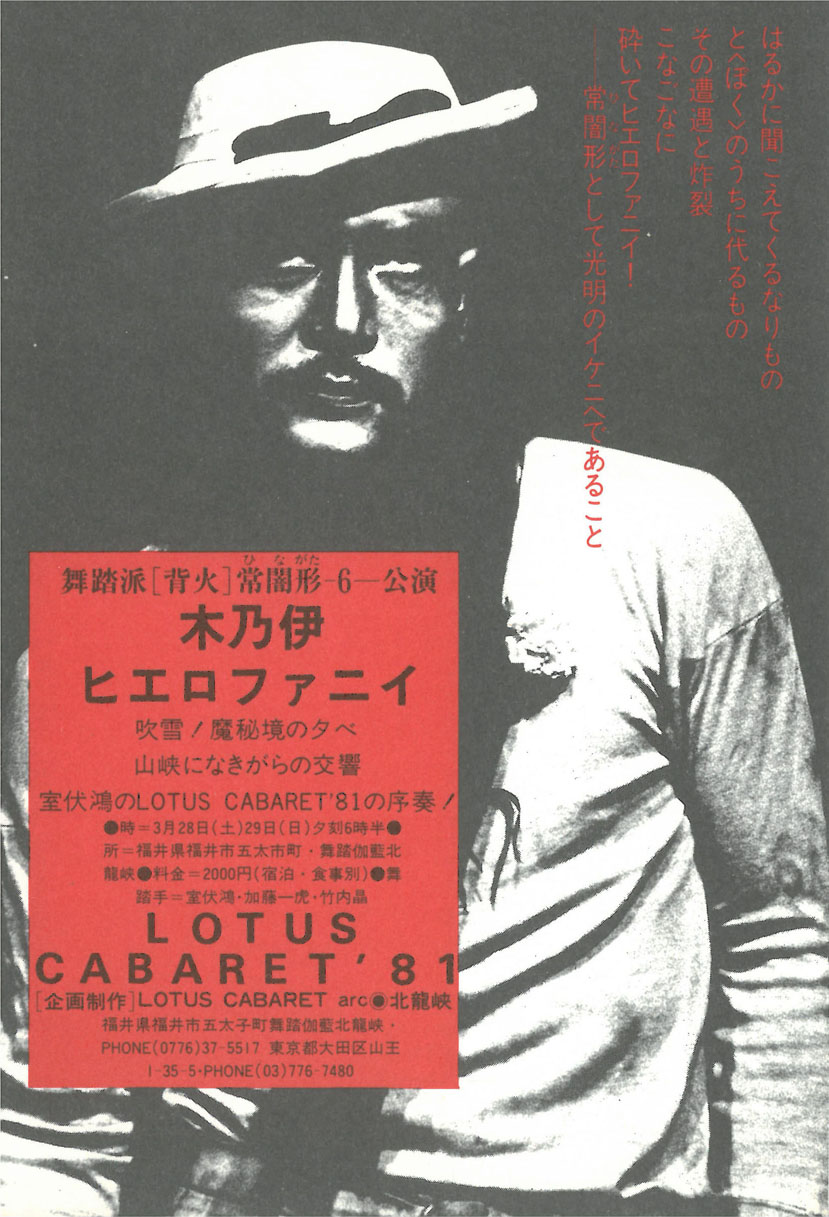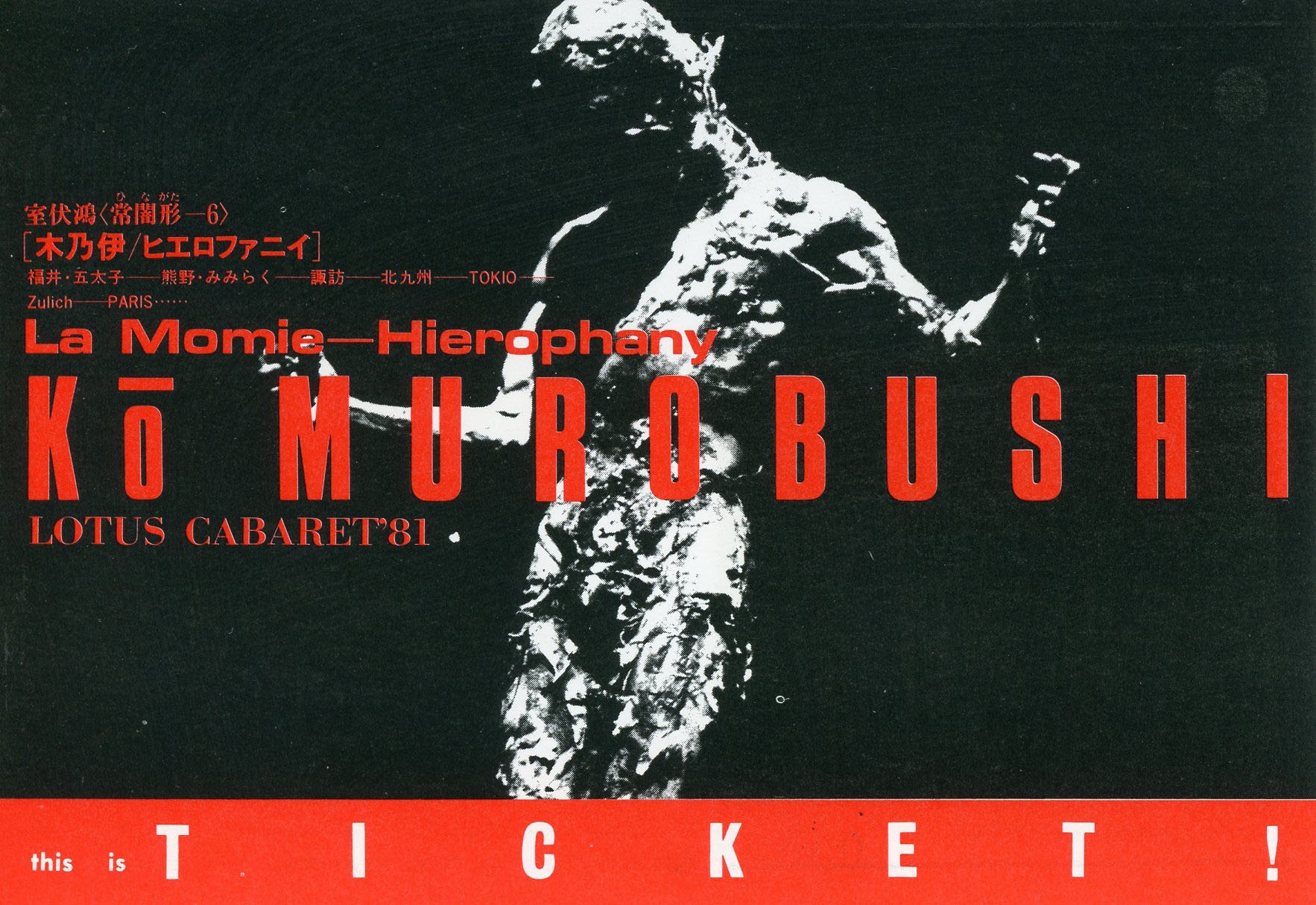
Suichu no Katsugeki – Shizuka na Utage (An action play underwater – A quiet banquet)
S
There are two orientations to Ko Murobushi’s nikutai (carnal body). Two orientations that are basically split yet, moreover, joined together in an indifferential way. Let’s make it simple. Ko Murobushi’s nikutai is a mineral. On one hand, it is a hard jewel that has been polished with care; on the other hand, it is a kind of dust that is nothing and connects one with the other, blown along with the wind. Naturally, it is not that the two coexist in the present. Something like that would be impossible. Depending on the moment, either one inclines. In terms of orientation, Ko Murobushi’s nikutai has two.
When did Murobushi come to possess this pendulum? At the time of Dairakudakan, there was a metallic image to him. Perhaps this image was created by the dance with the copper sheets seen in “Danniku Monogatari” (1974). My heart pounds even as I think back to it now. It truly was a vivid Butoh dance. The upstanding sheets of metal that reflected a dull light, bending as if suddenly turning over itself, began to dance. The audience, for an instant, does not know what has happened. When they come back to their senses, the copper sheet becomes manipulated by a single man, and the man approaches, in careful steps, then goes off into the distance. It is in this way that Ko Murobushi gave birth from a thin sheet of copper.
That was the image that he brought about. If one looks from behind the stage, at the time, Ko Murobushi must have hidden himself in the shadow of the copper sheet and waited patiently there for his turn. It may have been that the sheet of metal was not copper. However, in the moment of his entrance, when he leapt above his obstructions, he had acquired a brown skin—nobody saw this “moment” that might be pure secret meeting between metal and him— that is what one cannot but think.
First, the acquisition of a direct sense of tension. After his time at Dairakudakan, it must have been a transition period for him. Rather than saying that the dance that he collaborated with Isamu Osuga on was a pure metal, it had the impression of an amalgam. Of course, it is not a negative thing. If one wishes, it is possible that an amalgam can be the “ultimate form” of Butoh. It is only that Murobushi intentionally did not pursue it. Another is, what of the part that is the dust blown with the wind? Where will it hide itself?
Hokuryukyo. From forming the Butoh group Sebi to the forming of the Butoh monastery “Hokuryukyo” (1976). It is likely that he had slowly made the transformation during this time. It was clear that the dance of “Mummy” in the Dairakudakan Toyotama Garan theater’s “Binbo na Hito” (1979) was different than that of before. It was not that the sharp tension that pierces through the entire body had only increased and reverberated painfully before as well. Something fluttered in the wind. Nor was it that the drynesss of the mummy had weathered. Firstly, the Mummy was not something of the desert. It may not be possible in actuality, but containing a good amount of moisture and half-liquid, it can only be called, how should I say, the “Mummy of Japan.”
“Towards the edge (kiwa), the tip (heri), the corner (sumi), the country (hina), the everlasting darkness (hina) of existence…” That is what Murobushi said. Keeping the tension and the tension of the muscles that could only be centripetal and replacing it with another things. It is impossible. But the nikutai that repeatedly spasms also breathes. What breathes in, breathes out. And so, Murobushi succeeded in becoming a Mummy that breathed.
Now for Ko Murobushi’s recital, Hinagata 6’s “Mummy ──Hierophany.” It is truly the physical Mummy of what is called the “hierophany.” The Murobushi here is light. The Zojoji Hall that had become the venue is underground the main temple. Perhaps it is from the daylight, but the main temple as seen from the gate had a shallow sense of presence, as if looking at a holograph. As I descended the slow steps, I was overcome by an ominous feeling. It was just like a crypt. The audience is sucked into the dark grave.
The light fades, and the sound of the ocean reverbs. No, in actuality, it is not the sound of the waves, but the sound of chafing of the Japanese paper the three Butoh dancers were clothed in. But this is an action play underwater. It is the quiet scene of a banquet that is repeated in a submerged tomb. It does not display the world that is not yet known, the illustrated customs of the “natives” or the clothes enveloping Ko Murobushi’s nikutai that too were all too light. Rather, it was slightly shifting and overlapping two well-known images. It is fine to follow the wall paintings of people from ancient times and mix them with our enjoyable imagination. Butoh is located within the “mountain of analogy.”
The two orientations of Ko Murobushi’s nikutai are still in its infant stages. To turn the nikutai into metal, metal into mineral, and mineral into something of no weight. Perhaps that is what can be called alchemy in the midst of everlasting darkness that continues on into eternity.
*The Ko Murobushi recital was shown at the Shiba/Zojoji Hall on May 8th.
